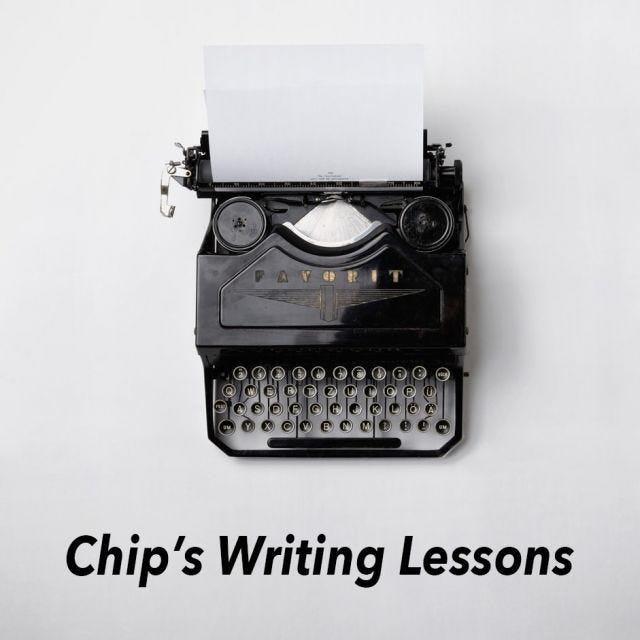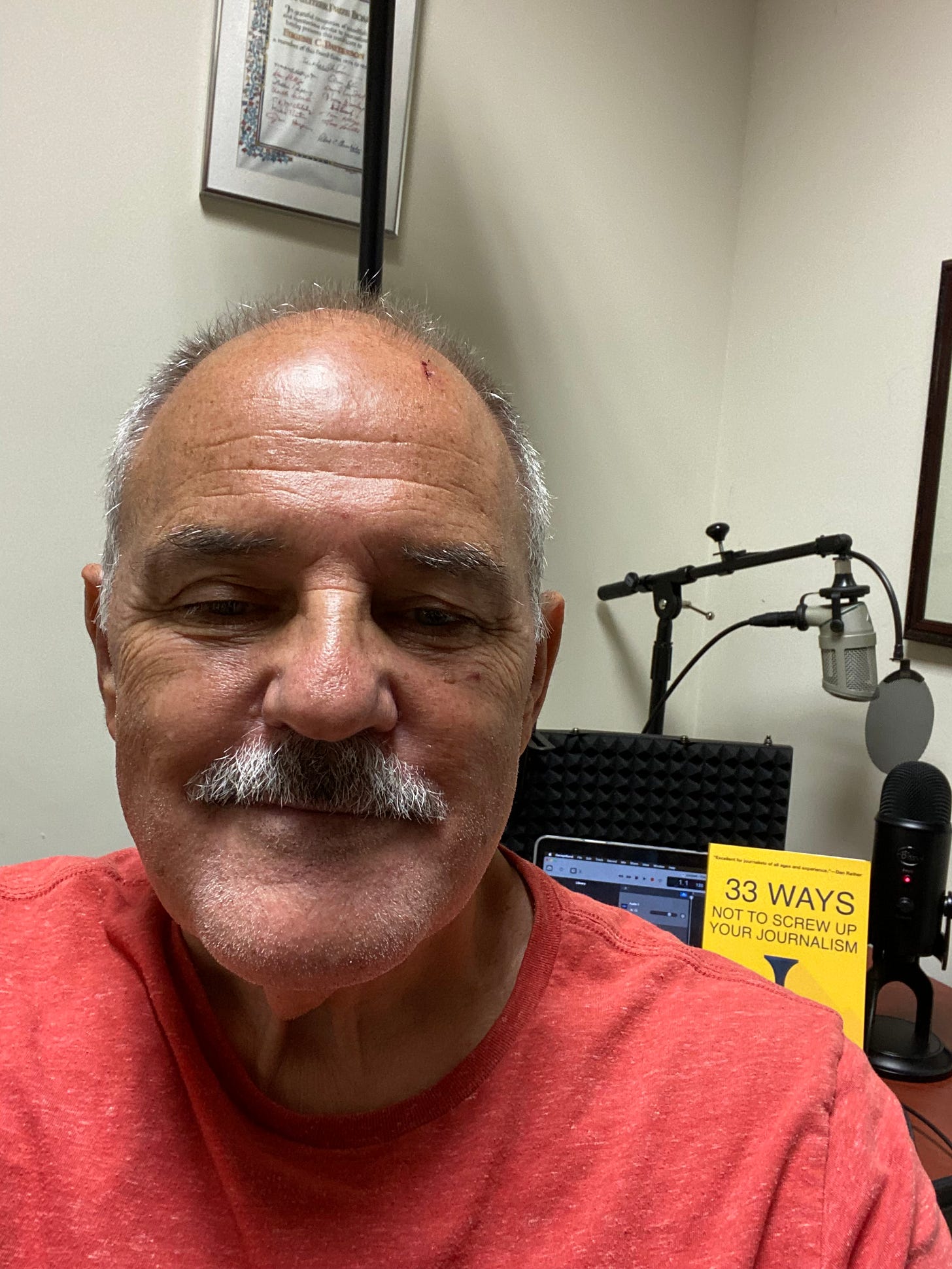Writers Speak | Rita Dove on wrestling with language
Interview | 4 Questions with Jeff Pearlman
Craft Lesson | Embracing revision
Writing to Savor | “The Weight of Bones,” by Jennifer Filardo, Sunday Short Reads, June 12, 2022
Book World | The recording light is on
Tip of the Week | Let the dough rise
Help Royal Hospitallers save lives in Ukraine
WRITERS SPEAK |
"I wish I could explain the mystery of that moment where everything sparks and starts to come together, but what I love to do is wrestle with the language--because the language is what a writer has. It's our tool. It's our clay."
- Rita Dove
INTERVIEW | 4 QUESTIONS WITH JEFF PEARLMAN
Jeff Pearlman is the New York Times best-selling author of nine books and the host of the Two Writers Slinging Yang podcast. His weekly journalism substack can be found at pearlman.substack.com
What’s the most important lesson you’ve learned as a writer?
Nothing is as important as I used to believe. I used to live and die with every word, every paragraph, every comma and period—and if an editor dared mess with my copy, I’d prepare for battle. Over time, I’ve come to understand three things: A. I’m not nearly as good as I once thought I was. B. It doesn’t matter nearly as much as I thought it did. C. The stuff that infuriates you as a writer—the reader almost never notices. Like, “You’ve ruined this story by [doing X]!” is almost always nonsense. So having those realizations set me free. And, I hope, made me better at this job. I take myself far less seriously.
What has been the biggest surprise of your writing life?
My dream from boyhood was to become a Sports Illustrated writer. It was everything I wanted. The goal of all goals. Then I achieved it at a fairly young age (I got to the magazine at 24) and sorta kinda came to the surprising realization that chasing a dream is oftentimes more engrossing than the dream itself. I arrived at SI in 1996. I left in early 2003. I loved it—but after a while, it grew sort of stale and repetitive. The dream was 50 years of SI bliss. The surprising reality: It lasted a mere six years.
If you had to use a metaphor to describe yourself as a writer, what would it be?
I’m the chef who never likes his own food. I just find it really hard to not see the warts. I’ll read something I wrote and find every single regret. A word I accidentally used twice. A sentence that sounded better in my mind than it does on the page. On and on. I try making a meal to be served at Per Se, but most of the time it feels like a soggy Whopper Junior.
What’s the best piece of writing advice anyone ever gave you?
My first job was as a features writer at The Tennessean in Nashville. I was 24, straight out of college—and I couldn’t do anything right. Mistake after mistake after mistake. I didn’t listen to people, didn’t seek advice. I was just a cocky fuck. My editor, Catherine Mayhew, sent me to the late-night police beat. “Don’t worry about writing funky ledes, don’t worry about impressing anyone. Just get the facts.” It changed my life.
CRAFT LESSON | EMBRACING REVISION
Journalists spend most of their time reporting. That’s their job, after all. Then, as the clock ticks toward deadline, they start banging away at their keyboard, desperately trying to compose a coherent story.
Revision? Heck, they’d tell you, I'm just trying to get the darn thing written. And if I turn it in late enough, the editors can’t tamper with my flawless prose.
Journalism is essentially a first-draft culture, and therein lies the problem. Until you overcome resistance to revision and start seeing it as the chance to improve your stories, your readers will find it easy to quit reading.
Granted, sometimes there isn't time for anything but a first draft. But just because journalism is “the first rough draft of history” shouldn't give writers—and their editors—an excuse to publish hastily edited first drafts every time.
A POP QUIZ
When I hear the word “revision,” I think…
1. I should have gotten it right the first time.
2. I have no clue how to revise my story.
3. I don’t have the time.
4. Yippee! I’ve got another chance to make it right.
Revision is the key to making a story shine, but not many working and student journalists I’ve coached choose number 4.
Instead, they beat themselves up with the first three responses.
Revision—literally to “re-see”—gives the writer the opportunity to reconsider, reorganize and rewrite until the story reflects an acute clarity.
It shouldn’t be confused with proofreading, the final step before publication that examines the story to correct typos, misspellings, style departures and grammar flaws.
The biggest problem with revising is not the words, it's the attitude.
As a young journalist, I used to hate the idea of revision. I told myself that I’d get it right the first time if I were smarter. If I were really talented, my writing would emerge fully formed; no chrysalis but a beautiful butterfly. An engaging lead, logical transitions that drew in the reader and a resonant ending. A home run on the first pitch.
If I had to rewrite my story, it meant one thing: I've failed.
But over the years, I've had a change of heart, and you can, too.
I am inspired by writers such as the acclaimed novelist Toni Morrison, who said “the best part of all, the absolutely most delicious part, is finishing it and then doing it over … I rewrite a lot, over and over again, so that it looks like I never did.”
Treat revision not as punishment, but as an opportunity for each draft to teach you how to write the next one. “Revision,” as Rosalind Bentley, a features/enterprise reporter at the Atlanta Journal-Constitution, told me, “is your friend.”
REVISION STRATEGIES
1. Write earlier. This teaches you what you already know and what you need to know and builds revision into the process sooner.
2. Hit the print button. Computers are awesome, but they give the illusion of perfection. Shifting to another medium will give you the distance you need to see your story in a new light. Mark it up: “cut?" “move up?” “boring?” “stronger evidence?” Quickly make the changes on your computer. If there’s something you don’t know how to fix, move on. In the next version, the problem may have vanished. If not, cut it. Repeat the process as many times before deadline.
3. Put it away. Take a walk around the block. Chat with a colleague in the break room. Any attempt to put a story out of your mind, however brief, will give your unconscious mind the chance to work on it.
4. Read aloud. Listen to your story and you can hear where it lags, where a quote runs on or echoes the previous phrase.
5. Find a beta reader. Before you turn in your story, ask a friend or colleague to look at it. Ask them to tell you what works and what needs work.
6. Develop patience. When we begin to write, ideas often flow in a flood. Instead of a tidy piece of prose, what you have is a mess that makes your spirits droop. Keep telling yourself excellence will come, if you keep at it.
WRITING TO SAVOR | “THE WEIGHT OF BONES,” BY JENNIFER FILARDO, SUNDAY SHORT READS, JUNE 12, 2022
When you spend your days consuming news and narrative nonfiction, as I do, Creative Nonfiction’s Sunday Short Reads is a welcome weekly tonic. Narrative nonfiction, limited to 750 words. I loved Jennifer Filardo’s 169-word micro essay that considers the loon and demonstrates that brevity is, indeed, the soul of eloquence. She gifts you with a wonderful meditation on this misunderstood creature, its world and brightens it with her questions: “Who cares if the owl continually asks questions? Who cares if the sparrows chitter at him and his mate, flitting about from branch to branch, taunting him with the ease of their flight? Let them think he is mad. See the twinkle in his red eye? Only he knows the color of the sky seen through lake water.”
THE BOOK WORLD | THE RECORDING LIGHT IS ON
Over the past two weeks, I’ve been holed up in the soundless cocooon of the Eugene Patterson archives at my former employer, The Poynter Institute, to record the audiobook of 33 Ways Not To Screw Up Your Journallism. I learned that one writer paid $5,000 for an audiobook version!! But if they could afford it, they probably got a great job. To steep for my budget, and this is a personal book, so I couldn’t imagine anyone else describing my stories and advice.
I went DIY. On Amazon Prime, I purchased a:
Blue Yeti USB microphone ($110.55)
CODN Recording Microphone Isolation Shield with Pop Filter, High Density Absorbent Foam to Filter Vocal ($47.69) to baffle the sound. The pop filter, an oval screen you positin in front of the mic prevents “plosives,” those peskys “p’s” and “b’s” that you’ll spit into the audio.
All plug and play.
I quickly realized with a dog and grandkids underfoot, not to mention A/C hum and alley traffic, home was out of the questions. Ren LaForme, the talented managing editor of Poynter Online, kindly told me the Patterson Archives was used for recording, so I had a quiet place to work,
What remained was to remind myself to e-nun-ciate and be patient because you make mistakes all the time (as anyone who listens to my unedited newsletter podcasts (sorry, folks!). I used Garageband, pre-installed on my MacBook. It’s a quick learn.
Here’s what the setup looked like on my desk before I shifted to the Poynter studio:
There were many false starts and misspokes. I would record a chapter, listen to it and delete it if there wasn’t enough energy. Fortunately, the chapaters are short.
I did jumping jacks in the tiny room to rev up, guzzled green tea, and took regular breaks.
In the meantime, I had gone on fivver, the gig economy website where you can someone to virtually do any job for a more than decent price. I found Luis, an audio engineer in Venezuela. He agreed to edit a sample, suggested I tinker with the mic controls and get closer to it. I delivered all 40 chapters as mp3 files over WeTransfer.
Bottom line: in five days, Luis is going to deliver 33 Ways as a file ready to upload as an audiobook for Audible for just $135. (unless he doesn’t like my takes, which may means some do-overs, but am trying to be positive.
Lessons learned: don’t be afraid to tackle something entirely foreign. My learning curve was steep, but during the 10 days I spent narrating my book I grew more confident every session.
How an author feels when the job is done:
TIP OF THE WEEK| LET THE DOUGH RISE
Having trouble starting? Write a lead and then the light turns red?
I often encounter this problem when I have to write the introduction to the annotations—longform interviews with writers of longform narrative nonfiction- I do for Nieman Storyboard.
Firs thought: I can’t do it. I have no ideas.
But then I get an idea, even a little one, and throw it in a Google Doc.
Then I walk away.
Second thought: Got nothing else.
But I open the doc and there are words there, words I can examine and begin to connect and grow into more sentences.
I walk away again.
Third thought: I think I can do it.
This time, I lower my standards and finish a draft.
It occured to me that I’m like a baker sitting back and letting the dough she made with flour and water rise. Rising takes time.
Fourth thought: I’m not going to sweat these anymore. I’ll just let the dough rise.
Give it a try.
I am indebted for this tip to my friend Anne Janzer, writer of great writing books (annejanzer.com). In her Four Questions interview, she chose a baker as the metaphor that best describes herself as a writer. Read it about her process. It’s illuminating. If you do, you’ll see, I clearly absorbed (borrowed) her idea.
HELP UKRAINIANS PARAMEDIC SAVE LIVES
Royal Hospitallers, Ukrainian's brave volunteer paramedic battalion, saves lives every day. Please support them here!
BEFORE YOU GO
If there’s one person you think would benefit from the interviews, craft lessons, writing tips, and more that appear every two weeks in this free newsletter, please nominate them to subscribe @ chipscanlan.substack.com
If you’d like to tangibly support Chip’s Writing Lessons and my work, please consider becoming a paid subscriber. Once a week, these members receive an extras package featuring fresh interviews with leading writers and editors, excerpts from my books of writing advice, excerpts from a memoir in progress, more inspirational quotes, glimpses into the world of publishing, coaching tips and more recommended readings and listening options.
NOW AVAILABLE IN PAPERBACK AND EBOOK
Writers on Writing: Inside the lives of 55 distinguished writers and editors
“By asking four questions to 55 of our finest writers and editors, Chip Scanlan has hosted one of the greatest writing conferences you will ever attend." - Roy Peter Clark, The Poynter Institute, “Writing Tools”
"A marvelous book for writers, people who have a passion for writing, or simply, who want to become writers. Yet what strikes me about this book is that it is not just for writers only." - The Blogging Owl
AND
Writers on Writing: The Journal
Available on Amazon and through a local independently-owned bookstore @ writersonwritingbooks.com
chipscan@gmail.com | +1-727-366-8119
Thanks for reading. See you in two weeks.
May your writing go well.
Chip




